Note: I do not recommend attempting the adventure described in this post unless you are very confident in your abilities and fully aware of the risks involved. Please remember this blog’s unofficial byline of “Silly Things to do in Dunedin and Beyond”, and don’t put yourself in danger!
Having heard rumours of a spectacular columnar basalt formation near Blackhead known as the “roman baths”, the Wellness Walkers crew felt that this merited some investigation as a possible future walk. So some of our more experienced and adventurous members scheduled a date for low tide and gathered in the car park overlooking the beach, shadowed in turn by the quarry.
The early morning sunlight still had not reached the sands of Blackhead Beach when we arrived. We scrambled down a steep path to the loose boulders below. As we picked our way carefully over the rocks we were surprised by an odd crackling hiss from below – could it be sand falling through the cracks, or the last of the overnight ice breaking apart beneath our feet?

The only area in sunlight was the northern side of “the tooth”, a ridge of rock that has been preserved since a 1991 covenant which protected the coastline from the destructive effects of quarrying. This acts as a barrier protecting the rock formations – which have been compared to the Giant’s Causeway in Ireland – from the effects of falling debris.

This covenant was hard won. Quarrying here started in the 1950s and the headland has shrunk significantly over the decades as tonnes of rock have been removed for use in aggregate and road materials. The original plan was apparently to mine the headland clean away to a level of 50m below the waterline, then blast a gap so that the sea could run in to fill the hole, giving the local boaties a brand new harbour.
That kind of huge terraforming project was still cool in the 50s but by the 80s environmentalism had started to take hold, and a group formed consisting of surfers, journalists, environmentalists, botanists and local Maori – calling themselves the Friends of Blackhead. They negotiated with Fulton Hogan and the Department of Conservation to win the covenant that would protect the basalt columns, though quarrying is predicted to continue for another 40 years so we should expect the shape of the headland to continue to change.
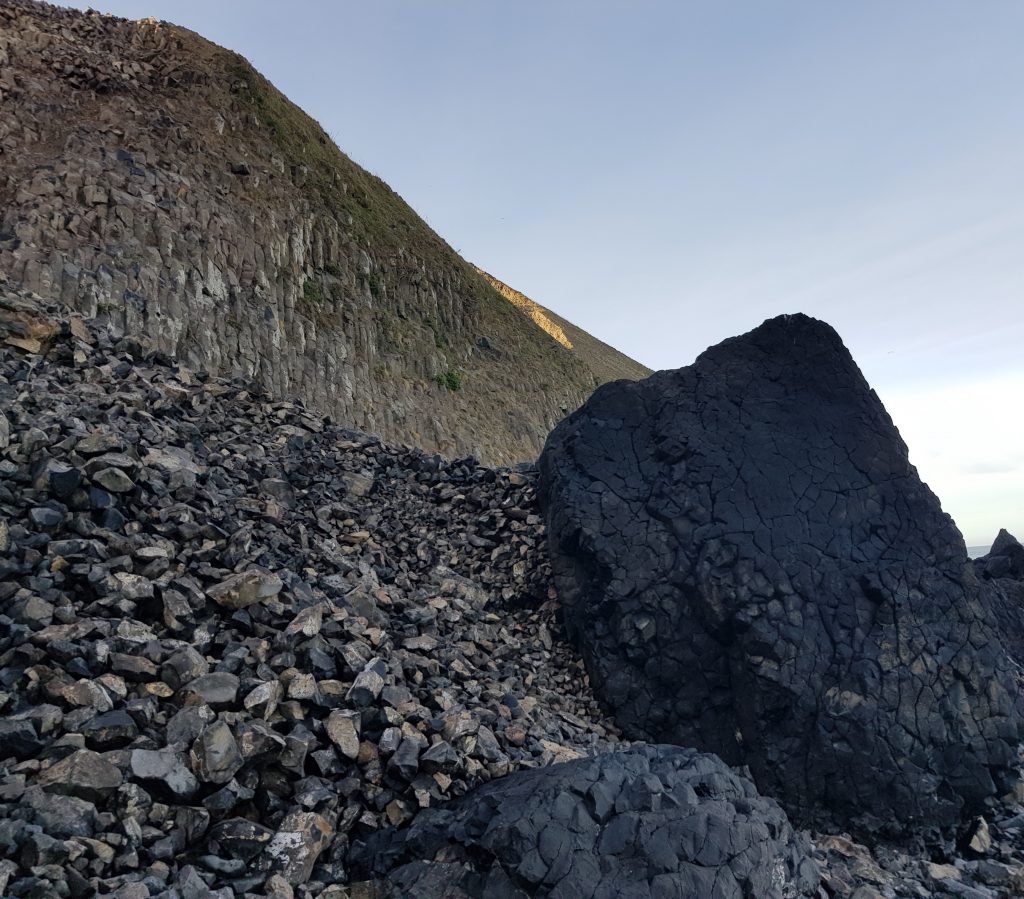
The further we ventured, the more strange pinnacles and enormous lumps of stone we encountered. Looming over our heads, above heaps of tumbledown rubble, rose the regular columns we have come to know and love from our own Mount Cargill Organ Pipes.
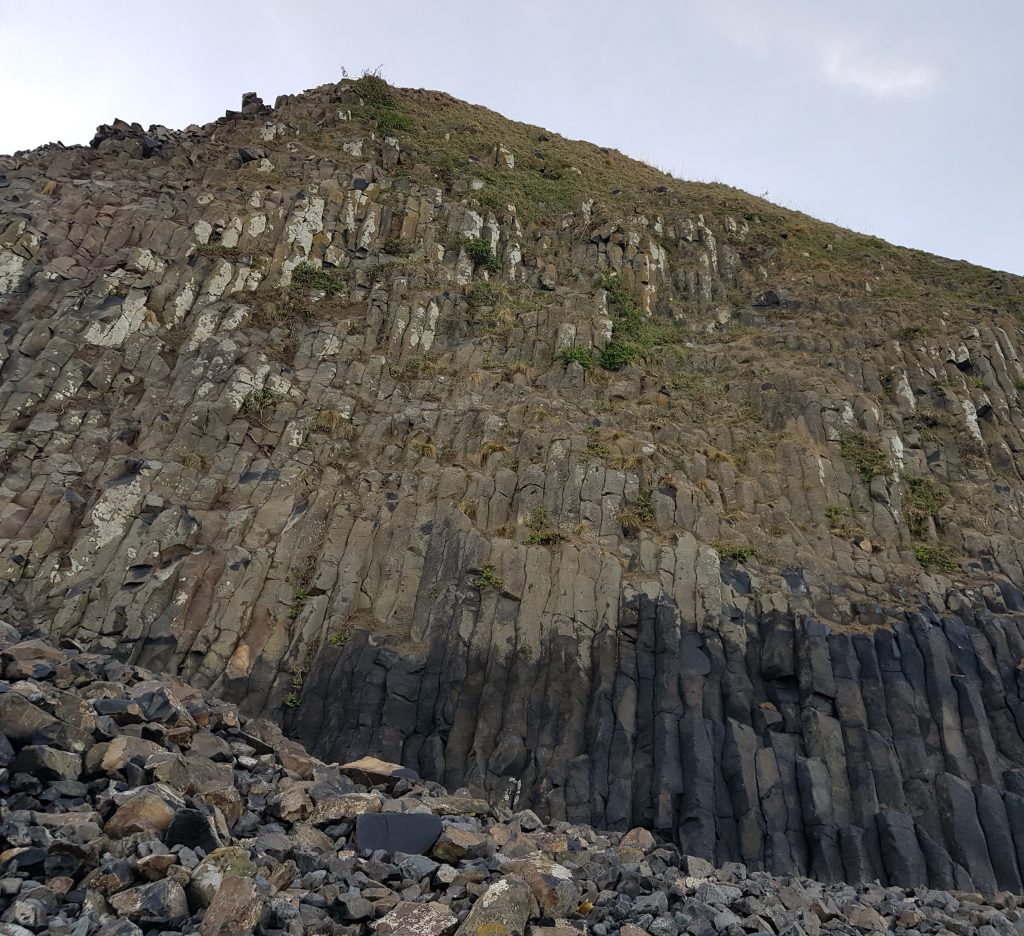
As we scrambled up the huge boulders at the end of the beach, it became clear that somebody had made the climb before us – somebody with no hands in fact! Sheltering in the lee of one of the largest chunks of fallen basalt were two big-eyed baby seals, watching us cautiously as we passed by.
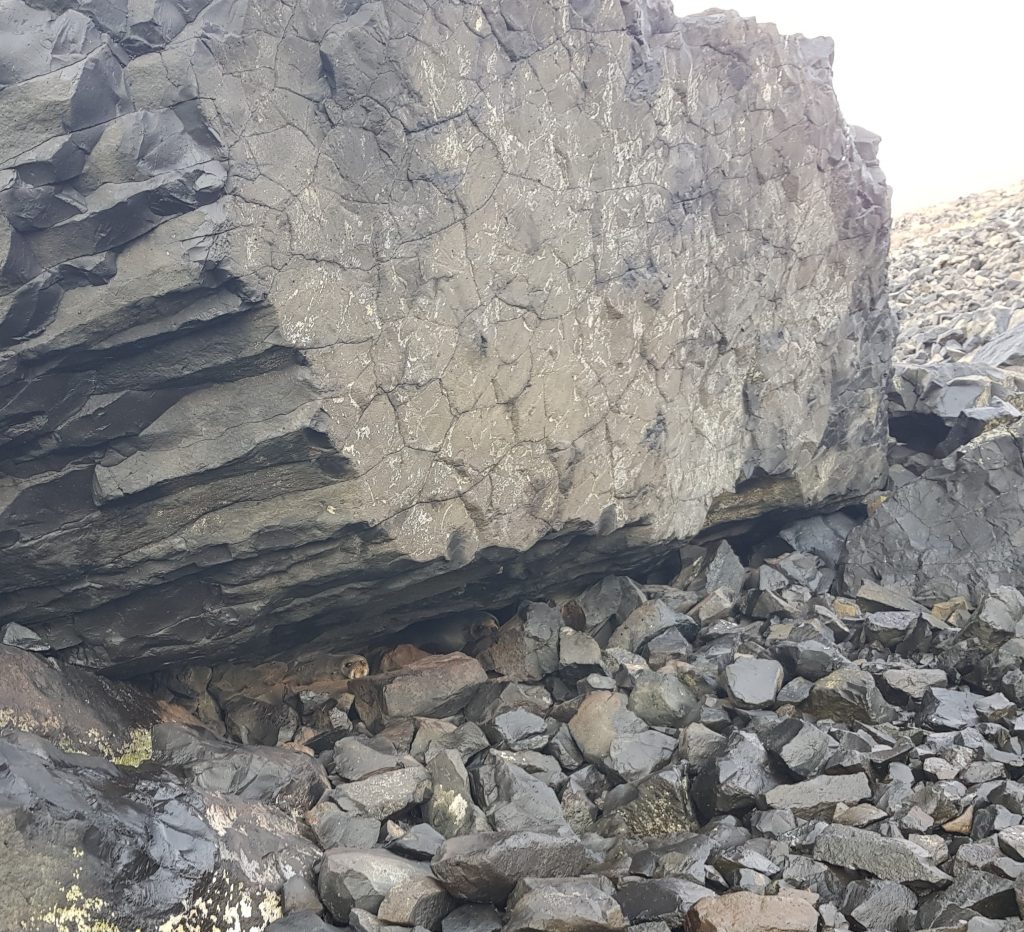
Finally we reached a steep slope of tumbledown rock, beyond which the jagged cliff plunged straight down to the ocean. It looked like this was the end of the road…unless any of us were daft enough to attempt the traverse of the near-vertical slope to see what lay beyond.
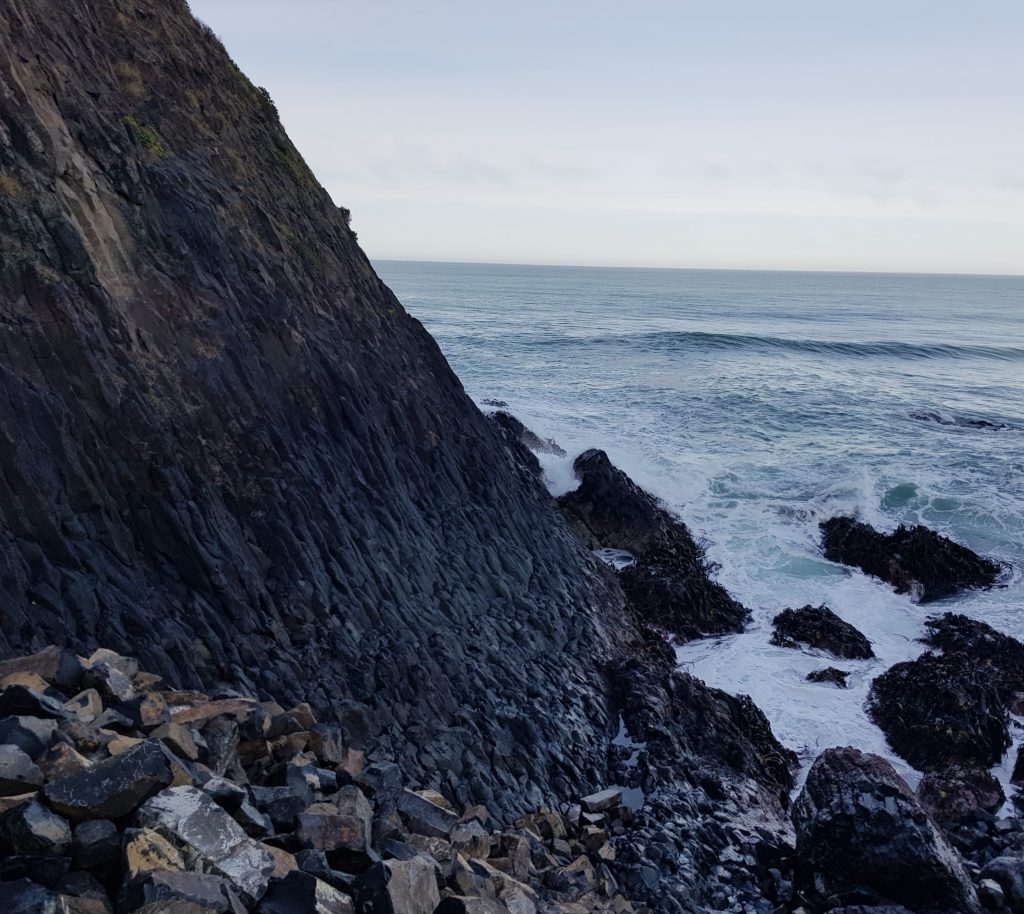
Hold on, did someone say daft? I’ll show you daft!
I set off along with three others to make the attempt, described in 1928 as a path that at low tide “no man and no confident girl will have any trouble on”.
Perhaps in 1928 they were made of sterner stuff.
Looking back at my less-foolhardy companions clustered on the ledge put me in mind of a huddle of penguins preparing to put out to sea. Of course, penguins usually wait to see if the first guy in the water gets eaten by a leopard seal, which would make me – to criminally mix metaphors – the sacrificial lamb.
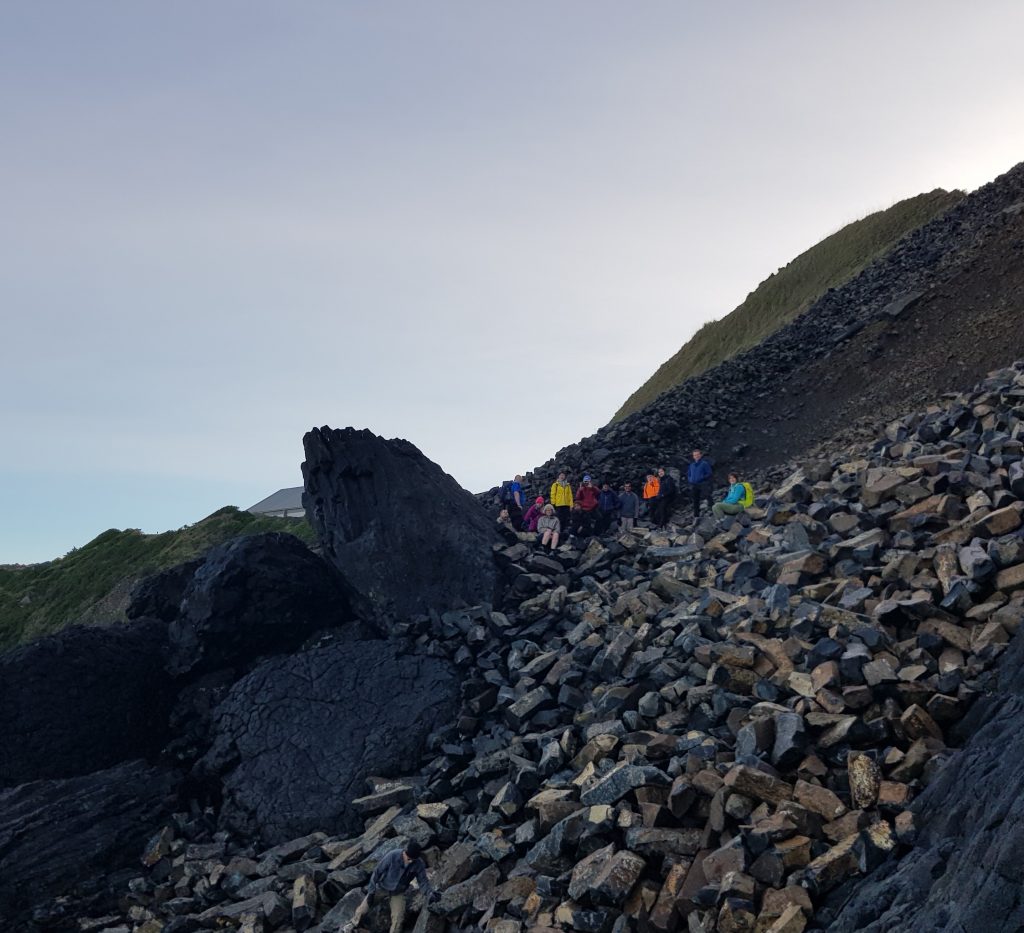
My first companion dropped back when the spray from a large wave caressed his buttocks, and another yielded to discretion after glancing at the churning sea below. That left two of us clinging to the rocks, which were actually surprisingly easy to climb, as the broken columns made good footholds while the sea had softened the edges somewhat.
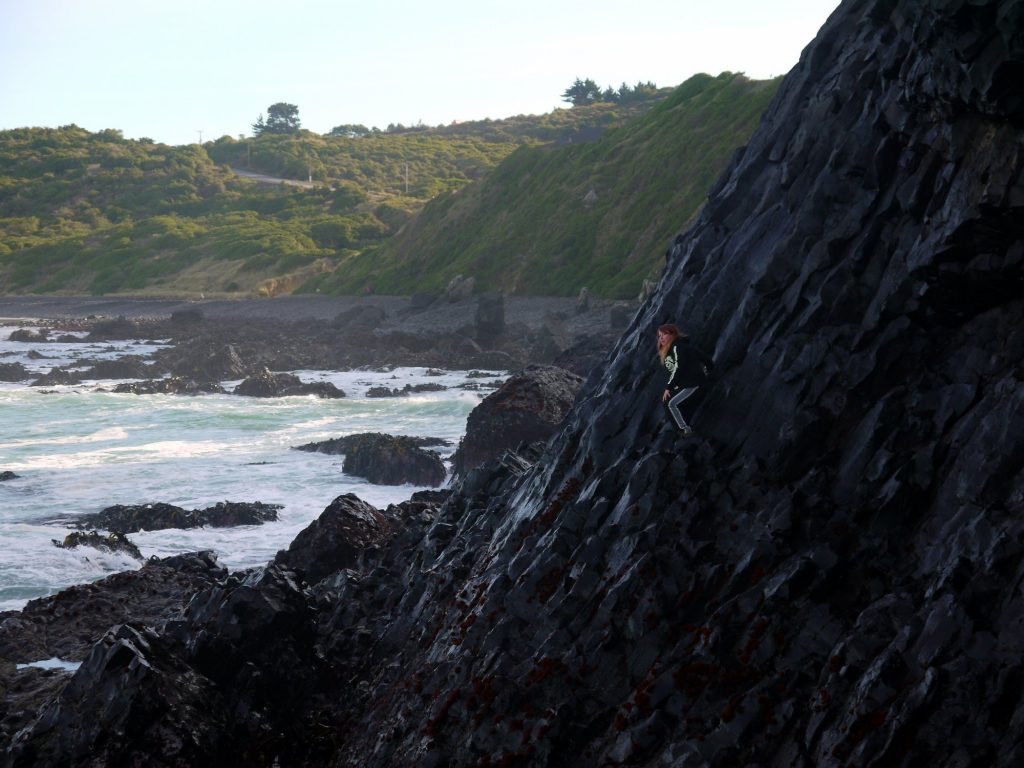
Clambering out of sight of my more sensible friends, I edged round the point only to find more sheer cliffs before me, beaten mercilessly by the booming waves. Below the waters fizzled over a jagged plateau, perhaps the place popularly known as “the Dock”.
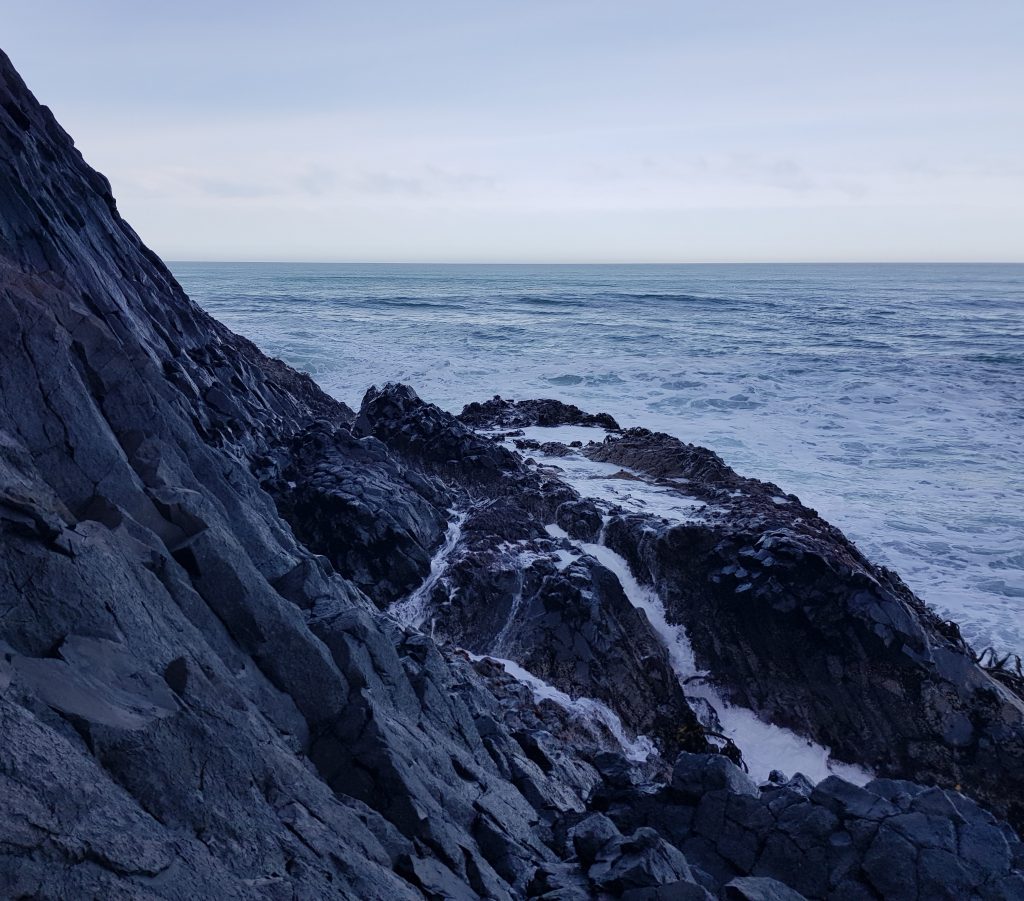
We continued in this manner for some time. I was belatedly beginning to feel anxious about the seemingly-endless black bluffs and ever-more-agitated ocean. The rock forms seemed to be growing only more huge and insurmountable, with huge jagged points and wide crevasses.
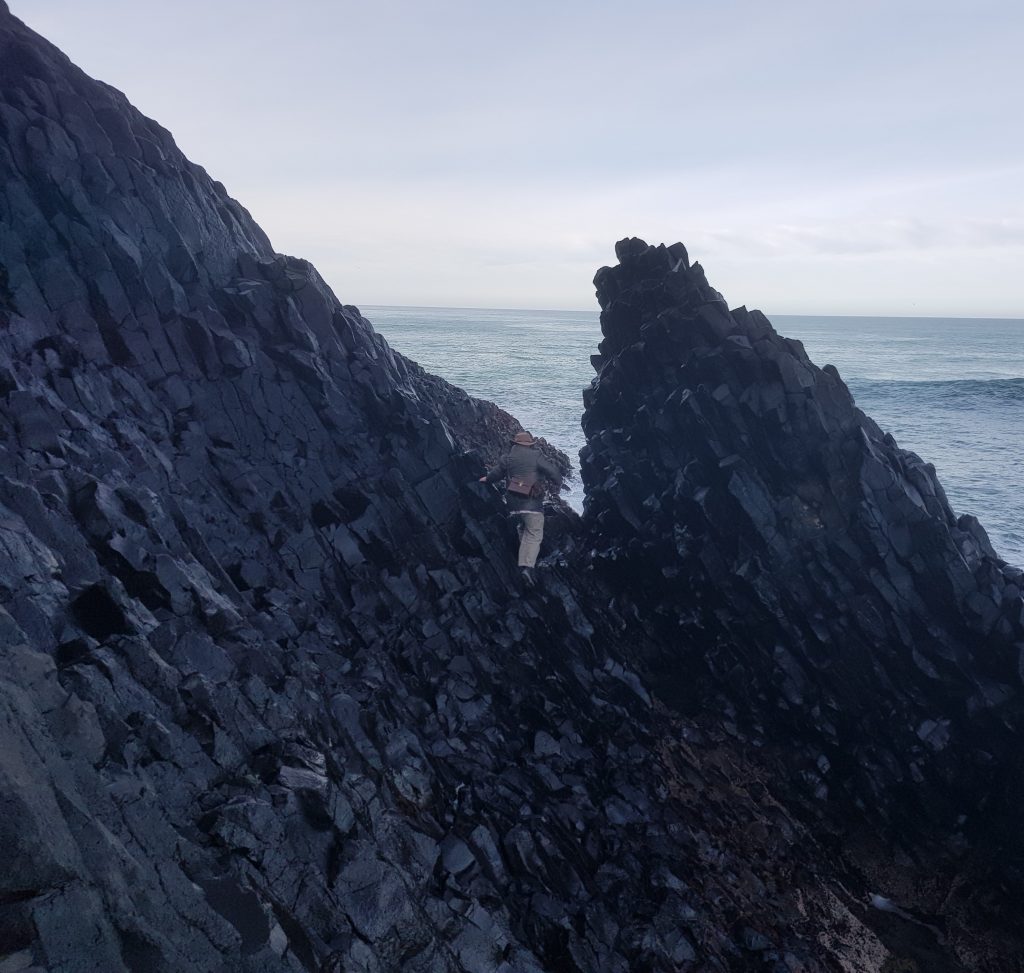
It was only as my courage finally reached breaking point that we rounded one more blind corner to find ourselves suddenly in reach of our destination. In fact, I almost found it by falling in.
Only one challenge remained to us, the scramble down into the cauldron.
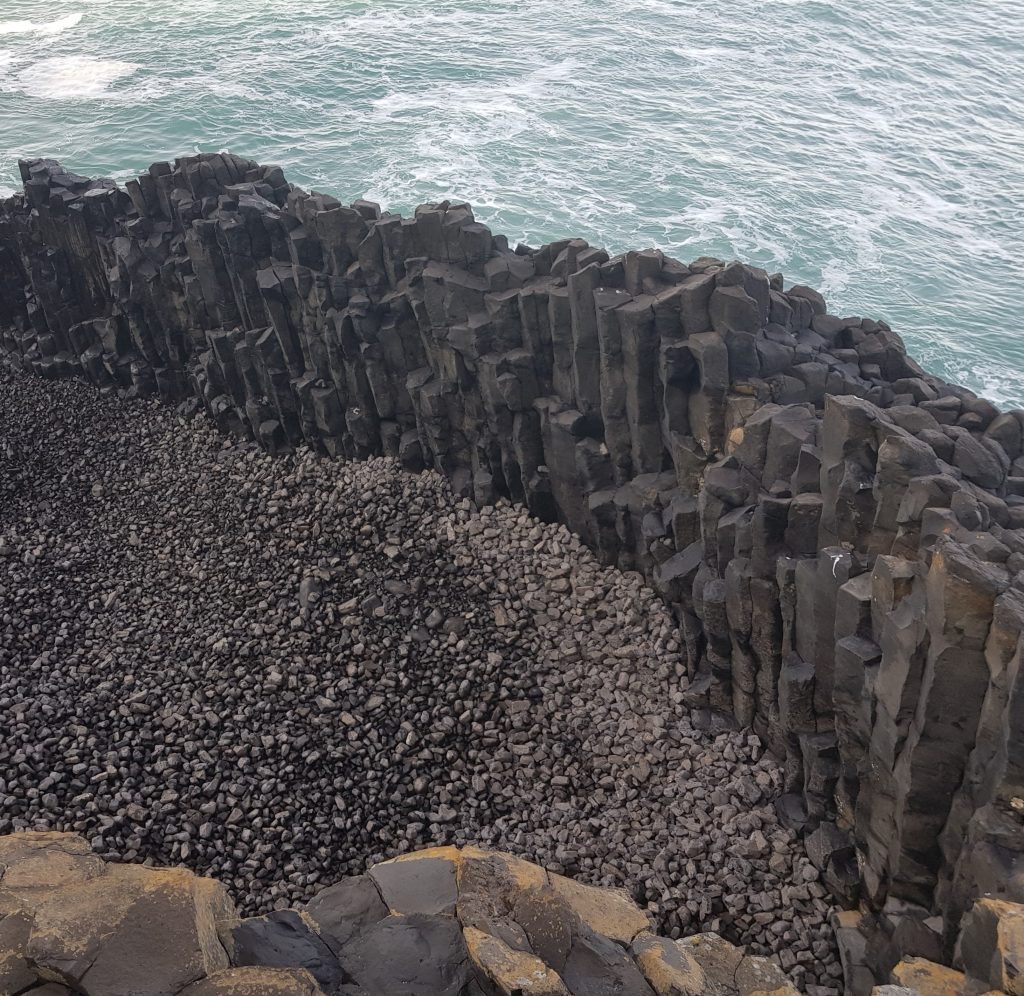
The bowl is filled with tumble-down rubble, possibly originating from pre-covenant quarrying activity above. According to the Friends of Blackhead, the quarry was supposed to clean this mess up, but never did.
But what strange force of nature formed this headland with its strange fluted outcrops? Blackhead is so-called due to its stark contrast with the rest of the surrounding coast – the pale sandstone cliffs to the north and the sandy beaches to the south.
If you search Google for the answer you will learn that Blackhead is a by-product of the “third main eruptive phase” of the Dunedin shield volcano. However any further information on this volcano or the origins of Blackhead are pretty scanty.
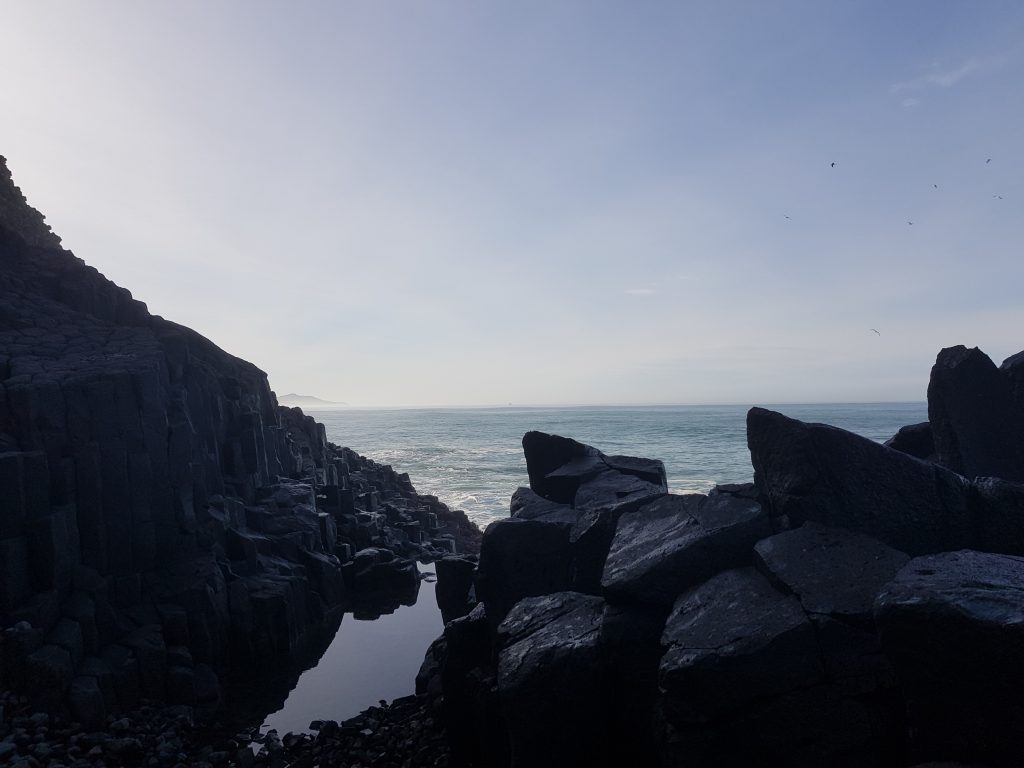
It took me three libraries before I actually found a decent summary of the Dunedin volcano and its weathered remnants.
It all begun perhaps 35 million years ago, as the tectonic plate upon which Dunedin now sits started to slowly stretch. Stretching leads to faulting, which provides handy pathways for magma to penetrate the mantle, and in the Otago region this began to happen at an approximate rate of one eruption every 50,000 years. Yes, once upon a time, Otago would have looked more like today’s Rotorua and Tarawera area.
The Dunedin volcano appeared 13 million years ago, under the ocean near where Quarantine Island now sits. The volcanic cone soon emerged above the water, and this “initial phase” created Port Chalmers and the most ancient parts of the Peninsula, such as Harbour Cone and the Pyramids. This was soon followed by the “first main eruptive phase”, as more lava was spewed out over a wider area.
This was followed 12 million years ago by the “second main eruptive phase”, in which ash and lava covered an area from Mosgiel to Waitati. Significant lava flows occurred around Leith Valley and Roslyn.
A mere 11 million years ago the volcano entered its third and final eruptive phase. This was centred further west, on Flagstaff, Mount Cargill, Swampy Summit and Mihiwaka. Several other extrusions occurred, such as Saddle Hill…and the one we are now standing on.
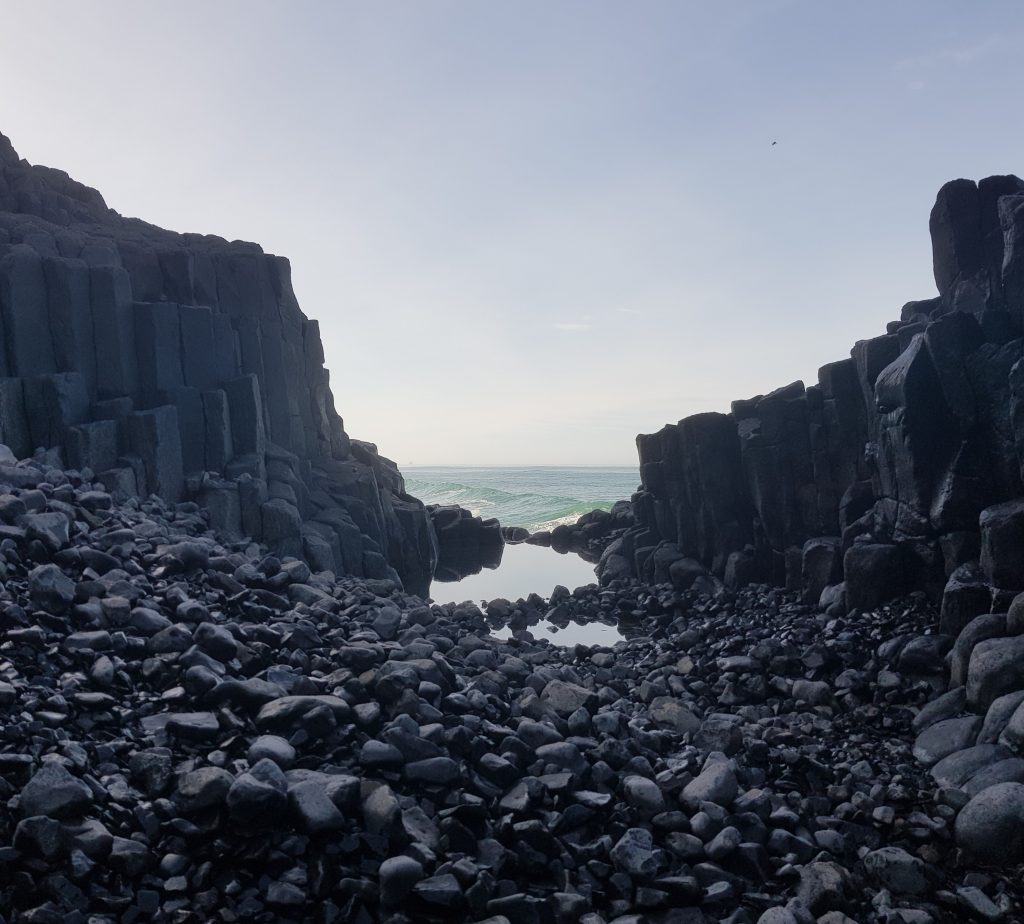
The basalt columns that we see today were formed where the hot lava pooled and then slowly cooled, contracting as it did so. As the material cooled it developed angular vertical fissures, eventually solidifying into these magnificent formations.
The Dunedin volcano may once have reached a height of 1000 metres (320 metres higher than Mount Cargill!), but much has eroded away in the intervening millennia. Today, you can only tell it was ever here if you read the geological signs juuuust right.
We’d made it to the famous site, and now we figured we’d better return before our companions began to worry. We retraced our steps (and hand holds), only to find that the sea had got more vicious since we’d passed. Huge breakers were rolling in against the cliff without a single sign of stopping. Unfortunately for us, these waves were inundating our escape route in quick succession.
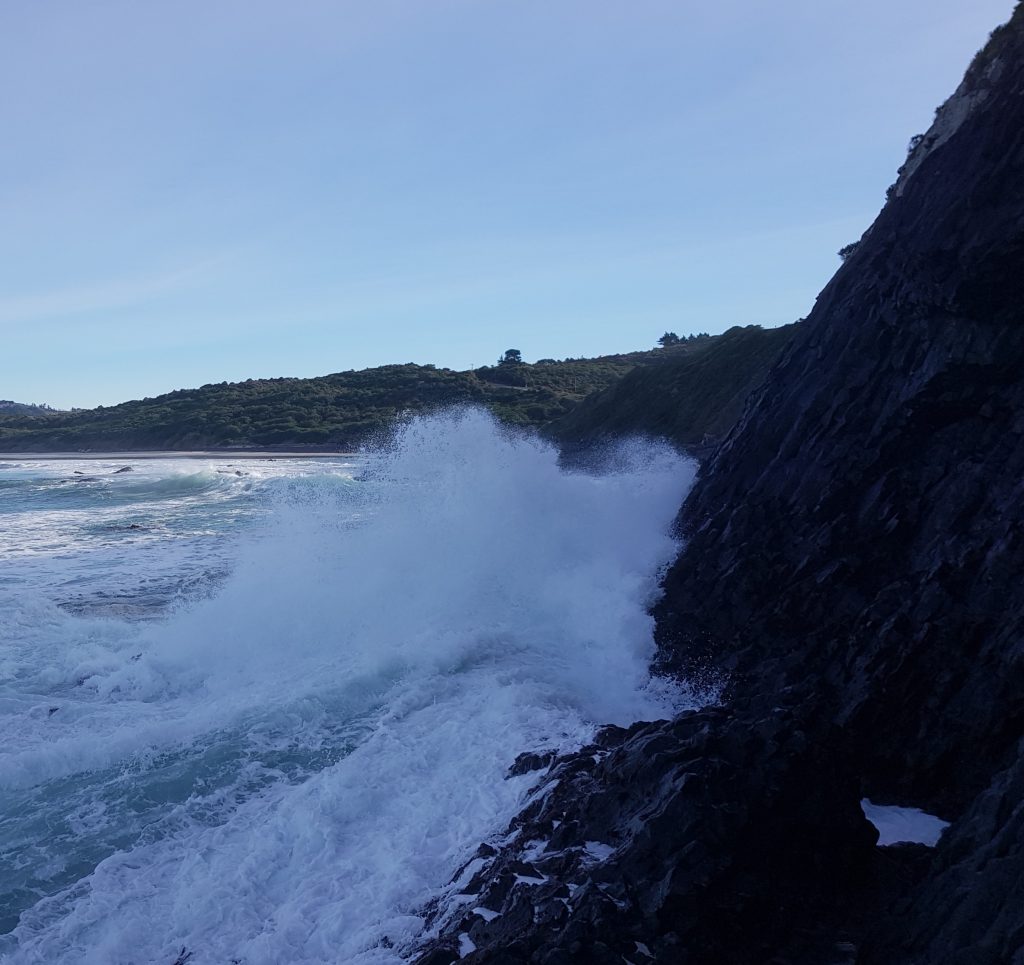
Should we come to grief against these waves, we would not be the first to be swept out to sea while in quest of the Roman Baths. Back in 2005 a woman was swept off these rocks and spent 45 minutes in the chilly sea before being rescued by a surfer.
We waited for several minutes, carefully tracking the waves before making a break for it at an opportune time. Lucky for us we had timed our crossing well and made it safely to the other side, where it was only a quick scramble before we were reunited with our friends.
Updating the walkers on our experience, the unanimous decision of the group was that this is not a walk for us. It’s difficult, dangerous, and involves more climbing than walking!
References:
40 more years of quarrying By Simon Hartley
Secrets of the Forgotten Tapu by Lloyd Godman
UNKNOWN DUNEDIN Evening Star, Issue 20166, 4 May 1929
Blackhead Basalt Columns (Dunedin, Otago)
The Natural History of Southern New Zealand by assorted authors
The Dunedin Volcano by Jane Forsyth and Glen Coates (New Zealand Geological Survey)
Rescue Came Just in Time by Blair Mayston
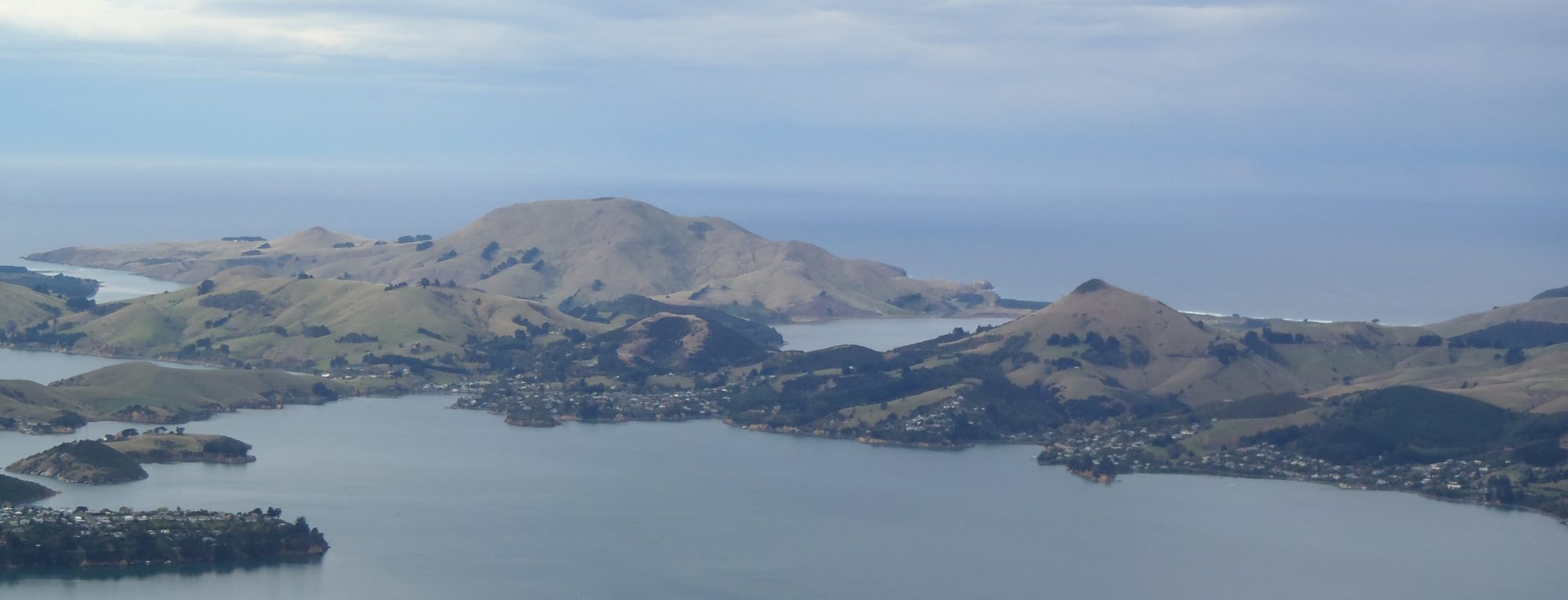

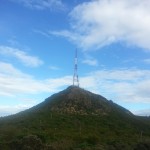
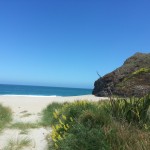
Wow good thing you Mother wasn’t there. Great adventure and very good photos.
Oh wow those formations were well worth the climb….fabulous exciting scary all at the same time.. Amazing history too – thank you
Great photos! Really spectacular but I think it looks a bit scary for me to venture around as far as you did!
It is really sad to see what the quarry has done to this incredible spot.
On a Sunday when the quarry is shut, I’ve heard you can walk through the quarry and down the slip on the north side of Blackhead. We have also followed the around the rocks route. Do it on a calm sea day and after the morning dew has gone. If the tide is low you can then nip along the beach to the massive Caversham Sea Cave! Past the Roman baths is not so scary as the first bit.